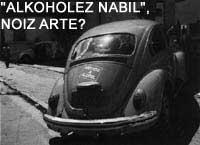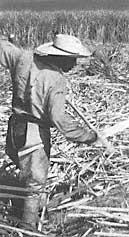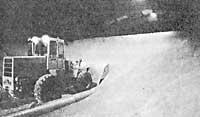Drinking wine...
1993/04/01 Irazabalbeitia, Inaki - kimikaria eta zientzia-dibulgatzaileaElhuyar Fundazioa Iturria: Elhuyar aldizkaria
When the oil crisis broke out in the 1970s, each state designed its own strategy to address the situation. In some places, such as the Netherlands, it was chosen to reduce car traffic and not circulate on weekends. Elsewhere, dependence on oil was broken and alternative roads were sought. This happened in Brazil. The oblivion of the oil crisis or the fall in black gold prices have endangered the successful biweekly experience of the South American giant, on the edge of the abyss.
One third of the 12 million cars in Brazil use ethanol as fuel from sugar cane and most of the other two-thirds do so through a mixture called gasohol (76% gasoline and 22% ethanol). However, several government spokespersons have stated that the production of cars circulating in ethanol will be interrupted from 2000. From then on, ethanol will become a mere gasoline additive. Environmentalists and environmental experts believe it would be a nonsense.
The thread of history

When the oil crisis broke out and black gold prices skyrocketed, the cost of oil imports in Brazil went from $400 to $4 billion in two years. This tremendous ascent prompted the government to seek alternatives.
The change to alcohol meant big investments for both producers and users. On the one hand, producers spent $9 billion on building 600 distilleries to increase the fertility of cane plantations and distill alcohol. All these investments have made the alcohol currently obtained from cane 40% cheaper than in 1979.
Car users also had to cope at first with higher costs, as the car running through pure ethanol needs changes in its engine (especially to combat oxidation). The cost of these changes is about $500 per car. The fuel tank of the car burning ethanol will be covered with tin, fuel pipes with copper and nickel and carburettor with zinc. In addition, due to the increased detonation capacity of ethanol, which consists of compressing ethanol/air mixture more than gasoline/air, the pistons must be reinforced and reinforced. Cars, however, have a problem: having difficulty turning on in the cold.
Initially, ethanol was used as a mere additive. The first simple ethanol cars appeared in 1979. The government subsidized cars and fuel, so 23% of cars sold in Brazil in two years were exclusively ethanol. The percentage increased and peaked in 1985, reaching 84.5% of cars sold from pure alcohol. Between 1990 sales rose above 80%, but the scarce yields of 1989 (because farmers planted fewer reeds than usual) and the consequent reduction in supply seriously affected consumer confidence in alcohol cars. Since then, the market share of alcohol cars remains around 30-40%, while the rest is diesel.
Thanks to ethanol, Brazil has saved $20 billion in oil imports in ten years.
What is the difference?
Alcohol cars have many points in favor, in addition to breaking dependence on external supply. Smoking alcohol is certainly greener than smoking oil.
The engine that burns ethanol generates between 20% and 30% less carbon oxides (II) than the one that burns gasoline and also the amount of sulfur oxide is very small. No acid rain. Both emit a similar amount of fireless fuel, but ethanol is not reactive in the atmosphere and does not affect the formation of photochemical smog. On the other hand, ethanol engines produce 15% less nitrogen oxides. And finally, carbon oxide (IV) produced by ethanol is mostly absorbed by growing the new cane. Consequently, it does not contribute to the greenhouse effect. Brazil is estimated to have reduced its greenhouse gas emissions by 20%. If we wanted to recycle the carbon dioxide (CO2) produced by the burning of oil, we would have to reform millions of hectares of trees.
Sugar cane also produces other benefits. The resulting rag after pressing the cane can be used to feed the animals or to produce electricity in high-pressure steam turbines. On the other hand, a liquid with high potassium content is obtained as a waste of distillation, which is a suitable fertilizer.
However, the main advantage of alcohol versus gasoline is its renewable. Ethanol will not run out during sugar cane growth. Oil, on the contrary, has limited days.
Against what?

The most consistent and common argument against ethanol is cost. In fact, while the cost of oil is $23, that of ethanol is between $30 and 40. However, environmentalists insist that the costs of oil pollution at this cost are not taken into account.
However, Brazil's problem is largely political. Both automakers and the state oil monopoly work for oil. The attitude of the former is understandable, since if all cars circulated with gasoline they would have to make a single type of engine. The second is not so understandable, at least from the point of view of public utility.
However, the greatest possible excuse for the energy of ethanol and other similar recoverable energies is not the cost, but the use of land. And when much of humanity is hungry, how far can land suitable for food growth for energy growth be used? What is the balance between food growth and energy growth? The preparation of the remaining land necessary for energy production, what damage can it cause to natural ecosystems?
Future
I have ever written that the four main characteristics of any future energy source are innovation, cleanliness, locality and diversification. These are the characteristics of ethanol in Brazil, so it is a good source of energy in this case. The energy of ethanol is not a universal solution. In Brazil there are different conditions to other regions and the extent of the territory, the climate and agricultural surpluses are not small. Therefore, they must be analyzed before taking steps forward.
Finally, it should be noted that Brazil's experience is not the only one, despite its heavy characteristics. In East Africa and the US, cars with gas tables also circulate.
Sao Paulo is the largest city in South America and its streets run 2.3 million cars. Of these, 1.2 million correspond to diesel (78% gasoline and 22% ethanol) and 1.1 million to ethanol. Gasoline cars were hidden in the past decade and although in 1990 the import of cars was allowed, due to large taxes, gasoline cars have been few. According to studies, if the 2.3 million cars in Sao Paulo were gasoline, carbon oxide (II) emissions would increase by 120%, those of non-combustible hydrocarbon by 100% and those of nitrogen oxides by 10%. On the other hand, if all cars circulated with diesel oil, carbon oxide (II) emissions would be reduced by 40%, those of hydrocarbons burned by 35% and there would be no changes in emissions of nitrogen oxides. And finally, if all are dedicated exclusively to alcohol, 20% less carbon oxides (II), 20% less fuel and 10% less nitrogen oxides would occur. The option is clear and clear to rule out photochemical smog. |

Gai honi buruzko eduki gehiago
Elhuyarrek garatutako teknologia






